Transistors are used a lot in guitar pedals. Sometimes they’re used for a general signal boost to create a clean boost pedal like a ZVEX Super Hard On, sometimes they’re used as building block as part of a larger pedal design, and sometimes they’re used to create awesome fuzz pedals. All in all, transistors are used a lot in guitar pedal building.
Since this is a DIY guitar pedal website, I mostly know about and concentrate on how transistors are used in guitar pedals, but even if you’re not interested in guitar pedal building, this article will probably still answer your questions about what hFE is in transistors, what it means, and why it’s an important metric when using and selecting transistors. Regardless of your interest in transistor hFE, you’ve probably heard the term mentioned before and you’re wondering why it’s important.
In this article I’ll define what hFE is, and then go into some more information how it works.
Defining hFE (And hfe) In Transistors
hFE, which can also be referred to as beta (β), is often used interchangeably with hfe (notice the small hfe). hFE is short for “hybrid parameter forward current transfer ratio.” So hFE or beta is easier to use… it’s simply a ratio of the current in the collector of the transistor versus the current in the base of the transistor.
So, for example, you may see a transistor with an hFE of 30. This means that if 1 mA of current goes into the transistor’s base, 30 mA will come out. That’s nice if you’re trying to make guitar go loud!
As mentioned, hfe is slightly different. Let’s look a bit closer.
Defining hFE (Or Beta)
Put simply, hFE is the measurement of gain for a bipolar junction transistor, or BJT. Specifically, it’s the measurement of DC current gain when the BJT is configured as a common-emitter.
I won’t go too far into it, but, put simply, a common-emitter configuration is called this because the emitter is shared by both the input and output circuits.
Defining hfe
hfe (written in lowercase) is similar hFE, but instead of being about DC current gain, it refers to AC current gain. When we’re talking about guitar pedals, we’re usually talking about AC currents, because the guitar’s signal is AC.
Since AC is a wave, rather than a steady electrical signal, measuring hfe is different to measuring hFE. However, for the purposes of this article and building guitar pedals, you can usually treat hFE and hfe the same.
This means, if you’re looking at a datasheet trying to determine the the gain of a given transistor, look for hfe, hFE, beta, or β. It’s pretty much the same.
Enjoying This Component Guide?
Learn more about transistors and other guitar pedal components.
How To Measure And Calculate hFE In A Transistor
As mentioned, hFE is the ratio of the current in the collector to the current in the base. That is:
hFE = Ic/Ib
Where I is the current.
Since you’re dividing current by current, this actually make hFE dimensionless, which I find mildly interesting, but that’s me…
Measuring the current in a transistor can be a bit of a pain, but if you want to work out the gain, that’s what you need to do. To measure the gain of a transistor:
- Send a known current into the base. To do this, use a known voltage (for example, 9 volts) into the base through a resistor of known value. You can then use Ohm’s Law to determine what the current is going into the the transistor’s base.
- Measure the current coming out of the emitter. To do this, connect another resistor in series with the transistor, and use a multimeter to measure the voltage drop across the resistor. Ohm’s Law is your friend again here to work out the current.
- Now you have the current going into the transistor’s base and the current coming out of the transistor. Use the formula above to work out the gain.
Transistor hFE Can Be Variable
Even for transistors of the same model number, the hFE can be different. That’s why transistor gain is often given in ranges like “30-50.”
The amount of gain a specific transistor can depend on all sorts of factors including the individual transistor itself, the weather, what its childhood was like, and whether you’re looking at it funny. This is even more pronounced with older germanium transistors. This is why you may want to measure them, especially if you’re using pairs where you would like a similar amount of gain.
However, a lot of the time, you should be able to go with what it says on the datasheet.
Transistors Can Operate In Different State Of Current Gain
Gain (hFE/beta) doesn’t stop just there, the fun really starts when you start make transistors operated outside of how they’re supposed to operate. Consider that current gain has three operating conditions:
Active/linear region: this is the region that the transistor is supposed to operate in. This is your basic amplifier. Here the transistor behaves as normal, with the collector able to provide enough current to cleanly amplify the signal. This is great if you just want a clean boost, but not as great if you’re looking for fuzz.
Saturation region: this is what happens what the base current equals the collector current. This is getting beyond the scope of this article, but basically, everything is on full throttle and there’s not enough voltage in the system to allow for anymore gain in the current. This will clip a signal under the right circumstances and create distortion. This is undesirable in a lot of amplification, but wanted in a lot of guitar pedals.
Cut off region: this is what is sounds like, the transistor is essentially off. There’s not enough voltage to get the current gain in the system.
As mentioned, the scope of this article goes beyond explaining the saturation region of a transistor and how to harness/avoid it. But when we’re talking about guitar pedals, it’s the saturation region that we’re after.
Other Transistor Metrics
Transistors have other metrics other than hFE/gain/beta. Here we’re obviously talking about bipolar junction transistors, but if you’re looking at a datasheet and wondering what the other stuff means, here’s a quick primer:
- Voltage gain (Av): while hFE is current gain, this is voltage gain; the ration of the output voltage to the input voltage.
- Power gain (Ap): again, like hFE, but for power.
- Alpha (α): this is the current gain in a BJT when it’s in the common-base configuration. So, while hFE is in a common-emitter set up, alpha is when it’s in common-base. Most of the time you’ll find alpha to be about 1 (i.e. no gain).
You’ve probably seen a whole lot more on transistor data sheets but, seeing as this article is quite long, I’ll call it here. It was fun writing this article though, so expect a few more!
Related posts:
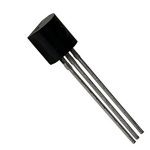 Ultimate Guide To Transistors In Guitar Pedals: What They Do And How They Work
Ultimate Guide To Transistors In Guitar Pedals: What They Do And How They Work
 The Difference Between Silicon And Germanium Transistors
The Difference Between Silicon And Germanium Transistors
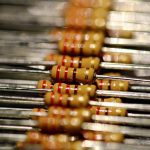 Ultimate Guide To Resistors In Guitar Pedals: What They Do And How They Work
Ultimate Guide To Resistors In Guitar Pedals: What They Do And How They Work
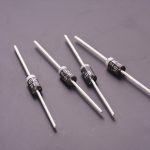 Ultimate Guide To Diodes In Guitar Pedals: What They Do And How They Work
Ultimate Guide To Diodes In Guitar Pedals: What They Do And How They Work
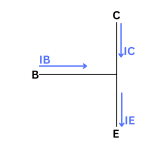 Transistor Saturation, Active, And Cutoff Region
Transistor Saturation, Active, And Cutoff Region
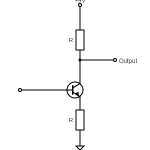 What Is Gain (And How It’s Different From Volume)
What Is Gain (And How It’s Different From Volume)
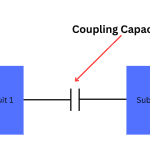 What Are Coupling Capacitors?
What Are Coupling Capacitors?
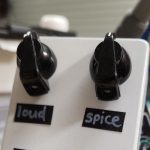 How Does A Drive, Gain, Or Distortion Knob Work?
How Does A Drive, Gain, Or Distortion Knob Work?
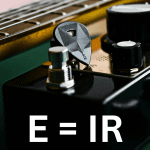 Ohm’s Law: Explanation And Applications
Ohm’s Law: Explanation And Applications
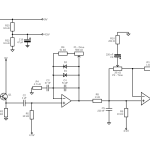 How To Find The Audio Signal Path For A Guitar Pedal
How To Find The Audio Signal Path For A Guitar Pedal
